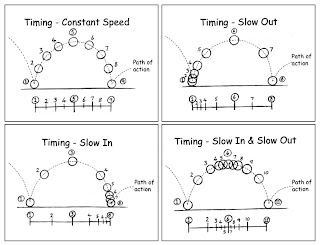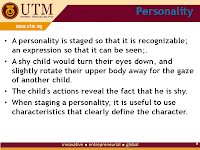Anyway, this outcome from our group for animation project.
Liz's MPT1383 Video Animation Reflection
Monday, December 31, 2012
Project Presentation
Today is our final project presentation for video and animation. But i can't join this session cause i'm still in my confinement session at home sweet home. Good luck all my friends... Thank you for my colleague for this project Fadlee, Diyana and Musa.
Anyway, this outcome from our group for animation project.
Anyway, this outcome from our group for animation project.
Monday, December 17, 2012
Week 15 : Last Class
Today is our last session for this subject but sadly i can't attend this class. I just deliver my 4th baby 3 days ago. Sorry Dr J, for this inconvenience.
Thank you friends for information about final exam tips given by Dr Jamal.
8 subjective question -4 in section A (video part) -4 in section B (animation part)
Answer any 3 Q from sect A n 3 Q from sect B Please answer in 2 different booklet.
*The questions are: -in Malay and English -from: slide, discussion and article
How to answer? -1-recall what u have learnt -2-application
-->always relate on WHAT, WHY and HOW
Example of past year question..
1. Give 4 basic animation principles and how the principle help an animator to produce a good quality animation.
-->can draw -->give example
2.jump cut scene/ cut away shot
Thank you friends for information about final exam tips given by Dr Jamal.
8 subjective question -4 in section A (video part) -4 in section B (animation part)
Answer any 3 Q from sect A n 3 Q from sect B Please answer in 2 different booklet.
*The questions are: -in Malay and English -from: slide, discussion and article
How to answer? -1-recall what u have learnt -2-application
-->always relate on WHAT, WHY and HOW
Example of past year question..
1. Give 4 basic animation principles and how the principle help an animator to produce a good quality animation.
-->can draw -->give example
2.jump cut scene/ cut away shot
Monday, December 10, 2012
Week 14 : StoryBoard Elements
Today we start class at 3.00 o'clock. Before start the class, we've disscus about the presentation date for final project video and animation and Dr Jamal was decide the presentation will held on 31 Dec 2012.
This week we start the class with lab activity for animation. Dr Jamal was show us some example of animation and how to create the animation. Here is my lab activity :
Second half of the class, Dr Jamal was explain to us about storyboard for animation.
Storyboard adalah perwakilan secara visual daripada screenplay dan terdiri daripada imej-imej dan nota produksi. Ia mengandungi beberapa siri panel untuk scene atau shot yang telah dikenalpasti pada screenplay yang digambarkan melalui rajah. Tiada standard yang khas dalam membina storyboard tetapi terdapat beberapa tamplet yang boleh diguna pakai untuk membina storyboard.
Ia Biasanya dilakarkan pada board, paper, preprinted paper with guide. Terdapat banyak sifat-sifat storyboard termasuklah dimensi, dimensi akan ditentukan melalui fungsi storyboard contohnya untuk pembangunan konsep atau untuk mempersembahkan konsep pada klien atau sebagai panduan untuk produksi yang sebenar.
Terdapat tiga jenis papan cerita :
From the preliminary interview in which Dr. Paula Messina explained what she does in the field, her Web site, and a review of an existing story, the content -- existing and anticipated -- broke down into:
Nonlinear parts -- Home page with four inside pages. The four parts are the quest (research), a bio (of Messina), the rocks (how they move), and the site of the dancing rocks, Death Valley's Racetrack Playa (its colorful history).
Video -- Anticipate video from the field trip: Messina mapping the rock trails, assembling her gear, the trip to and from the playa.
Audio -- Anticipate audio from the field trip: Messina explaining how she works, what the gear does, and why she does what she does. Maybe what the Racetrack Playa sounds like.
Still photos -- Available from Messina's Web site, and professional photographers, if necessary. Anticipate grabbing still photos from video of wide-angle shots of the playa, rocks and trails, maybe Death Valley National Park rangers.
Graphics -- Existing aerial photo, maps and rock trails.
Text -- History of research, history of the Racetrack Playa from interviews with Messina, other researchers, and the park rangers.
This is a sketch the rough storyboard (click for larger versions):
This week we start the class with lab activity for animation. Dr Jamal was show us some example of animation and how to create the animation. Here is my lab activity :
Second half of the class, Dr Jamal was explain to us about storyboard for animation.
Storyboard adalah perwakilan secara visual daripada screenplay dan terdiri daripada imej-imej dan nota produksi. Ia mengandungi beberapa siri panel untuk scene atau shot yang telah dikenalpasti pada screenplay yang digambarkan melalui rajah. Tiada standard yang khas dalam membina storyboard tetapi terdapat beberapa tamplet yang boleh diguna pakai untuk membina storyboard.
Ia Biasanya dilakarkan pada board, paper, preprinted paper with guide. Terdapat banyak sifat-sifat storyboard termasuklah dimensi, dimensi akan ditentukan melalui fungsi storyboard contohnya untuk pembangunan konsep atau untuk mempersembahkan konsep pada klien atau sebagai panduan untuk produksi yang sebenar.
Terdapat tiga jenis papan cerita :
- Conceptual Storyboard
- Presentation Storyboard
- Production Storyboard
Example - Dancing Rocks Rough Storyboard
Here's a rough storyboard for the "Dancing Rocks" story.From the preliminary interview in which Dr. Paula Messina explained what she does in the field, her Web site, and a review of an existing story, the content -- existing and anticipated -- broke down into:
Nonlinear parts -- Home page with four inside pages. The four parts are the quest (research), a bio (of Messina), the rocks (how they move), and the site of the dancing rocks, Death Valley's Racetrack Playa (its colorful history).
Video -- Anticipate video from the field trip: Messina mapping the rock trails, assembling her gear, the trip to and from the playa.
Audio -- Anticipate audio from the field trip: Messina explaining how she works, what the gear does, and why she does what she does. Maybe what the Racetrack Playa sounds like.
Still photos -- Available from Messina's Web site, and professional photographers, if necessary. Anticipate grabbing still photos from video of wide-angle shots of the playa, rocks and trails, maybe Death Valley National Park rangers.
Graphics -- Existing aerial photo, maps and rock trails.
Text -- History of research, history of the Racetrack Playa from interviews with Messina, other researchers, and the park rangers.
This is a sketch the rough storyboard (click for larger versions):
Monday, December 3, 2012
Week 13 : Animatic
Animatic : storyboard (static) add motion, tiny, sound etc to look nicer. It's also can called dynamic storyboard.
The Dissolving Process in Animation
Another technique in animation we learnt today is dissolve. Dissolving is a
method of transitioning between scenes in live-action film and video
production. Two videos overlap in the timeline; simultaneously, the lead
video's opacity decreases from 100 per cent to zero, while the second
video's opacity increases from zero to 100 per cent. This process is
also used in animation. The dissolve can also be employed to fade
objects and characters from view. There is an example of dissolve.
We also have lab activity in animation to apply several technique such as panning, zoom in, zoom out and also dissolve using black box and another one using another picture just adjust at the alpha properties. There is my lab activity :
Monday, November 26, 2012
Week 12 : No class for this week
Today we got message from Dr Jamal that class for today is cancelled and will be substitute to another time due to he was involved in pre-workshop at our faculty.
We were at the faculty actually when received his sms and we proceed to do our group assignment.
We were at the faculty actually when received his sms and we proceed to do our group assignment.
Monday, November 19, 2012
Week 11 : Principles of Animation
Before semester break, Dr Jamal have give us homework about the principles of animation. Dewi, Fadlee and Che Ku was presented their topic in class today. After that, Dr Jamal discussed the principles with details..
There are 12 basic principles of animation introduced by the Disney animators Ollie Johnston and Frank Thomas in their 1981 book The Illusion of Life: Disney Animation.
This principles Squash and Stretch is contracting and expanding movement within a shape as it moves through action. Also squash and stretch is useful in animating dialogue and doing facial expressions.
Appealing animation does not mean just being cute and cuddly. All characters have to have appeal whether they are heroic, villainous, comic or cute. Appeal, as you will use it, includes an easy to read design, clear drawing, and personality development that will capture and involve the audience's interest.
There are 12 basic principles of animation introduced by the Disney animators Ollie Johnston and Frank Thomas in their 1981 book The Illusion of Life: Disney Animation.
- SQUASH AND STRETCH
This principles Squash and Stretch is contracting and expanding movement within a shape as it moves through action. Also squash and stretch is useful in animating dialogue and doing facial expressions.
- SLOW-OUT AND SLOW-IN
- EXAGGERATION
- FOLLOW THROUGH AND OVERLAPPING ACTION
- ANTICIPATION
- the preparation for the action - this is anticipation
- the action
- the termination of the action
- STAGING
- STRAIGHT AHEAD ACTION AND POSE TO POSE
- ARCS
- SECONDARY ACTION
- TIMING
- SOLID DRAWING
- APPEAL
Appealing animation does not mean just being cute and cuddly. All characters have to have appeal whether they are heroic, villainous, comic or cute. Appeal, as you will use it, includes an easy to read design, clear drawing, and personality development that will capture and involve the audience's interest.
| "My mum told me never to forget my principles" |
Monday, November 12, 2012
Week 10 : Mid Term Break
During mid term break, we have homework to do. We need to choose 1 of 12 topic for Animation Principles from utm e-learning. My topic is "Staging".
There are my presentation slides that i have been prepared for presentation.
There are my presentation slides that i have been prepared for presentation.
Subscribe to:
Comments (Atom)








